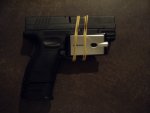Hi everyone, I was wondering if I could get some help or ideas for DIY project I would like to try. Currently, there a few laser dryfire products on the market used for pistol training. The idea is to replace live ammunition with a bore-sighted laser pointer which is activated by pulling the trigger of the gun. This allows for instant feedback on where a shot is placed while saving money on ammunition. Unfortunately, they cost a few hundred bucks.
So I was thinking about making my own dryfire laser, possibly by inserting the laser into a spent casing or a plastic dummy round. If I could then attach an on/off button to a wire, I could put it onto the trigger. The other option is a thin enough laser pointer/pen that could sit inside the barrel, but that would also need a method to get the on/off button to the trigger. Any ideas on how this can be done?
Below are some search terms (links had to be removed) for a demo of a dryfire laser, some images of dummy rounds, and then some product info on the dryfire lasers on the market.
Dryfire Laser Demo
At Google: videoplay?docid=-8192714298260014267&q=beamhit&ei=nOmPSNLXBZOGqgPSvuihCA&hl=en
Dummy Rounds
Saf-T-Trainer Dummy Ammo...
Dryfire Lasers
Beamhit, bullite...
So I was thinking about making my own dryfire laser, possibly by inserting the laser into a spent casing or a plastic dummy round. If I could then attach an on/off button to a wire, I could put it onto the trigger. The other option is a thin enough laser pointer/pen that could sit inside the barrel, but that would also need a method to get the on/off button to the trigger. Any ideas on how this can be done?
Below are some search terms (links had to be removed) for a demo of a dryfire laser, some images of dummy rounds, and then some product info on the dryfire lasers on the market.
Dryfire Laser Demo
At Google: videoplay?docid=-8192714298260014267&q=beamhit&ei=nOmPSNLXBZOGqgPSvuihCA&hl=en
Dummy Rounds
Saf-T-Trainer Dummy Ammo...
Dryfire Lasers
Beamhit, bullite...





